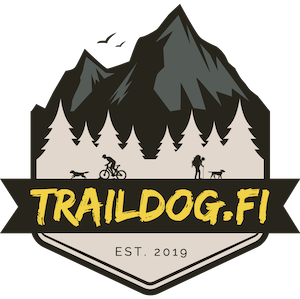Choosing a dog backpack
Dog backpack: where to start?
The first and most important tip for planning a backpack for your dog is: start early! If you are going to Karhunkierros in a week and your dog is not used to carrying a load on its back, be prepared to carry everything yourself. The dog's body needs enough time to strengthen the muscles and balance required for carrying the backpack. It is safest to first walk with an empty backpack and gradually start adding weight to the backpack in the form of training hikes. For this reason, renting or borrowing a dog backpack is also challenging, as the rental period should be at least a few weeks long.

Features of a good dog backpack
What then is a good dog backpack? Here is a 10-point list of things to pay attention to when choosing a backpack:
- Following the structure of pulling harnesses, the most ergonomic backpacks are based on Y-harnesses. The Y-shaped chest piece, which passes between the front legs, allows the dog's front legs to move freely – unlike the T-shaped one, where the chest strap runs across the dog's chest horizontally. Most dog backpacks have a Y-shaped chest piece.
- The most important thing is to choose a backpack that fits your dog perfectly. The same points largely apply to checking the fit of the backpack as with harnesses. Read the Traildog article: How to fit pulling harnesses. Also check that the backpack's center of gravity is on your dog's upper back, not the mid-back!
- Do you want the backpack to also function as just a harness? Some backpacks have detachable bags. In this case, the dog does not need separate harnesses for hiking (or necessarily for everyday use). The detachable backpack part is in the Ruffwear Palisades backpack.
- Other benefits of detachable bags: The bags are convenient to remove, for example, during breaks or when crossing water bodies. During the hike, it is sometimes good to let the dog walk without the backpack, in which case the separate bags can be tied onto the owner's backpack.
- Durable materials. The dog walks low to the ground, so branches and twigs scratch the backpack. If you don't want to tape the backpack after the first trip, pay attention to the quality of the materials.
- Water resistance. Quality backpacks have fabrics that repel water and mud and possibly taped zippers. To our knowledge, there are no fully waterproof dog backpacks on the market. A good way to protect the contents of the backpack is to pack everything in waterproof bags.
- Backpack weight and volume. If a person buys a backpack that is unnecessarily large, it usually becomes very heavy. So if there is space, it will also be used. Especially the dog's backpack weight should be kept moderate. As a general guideline, the backpack weight should be at most 20-25% of the dog's own weight (use your own judgment based on the dog's physical condition; for many, 20% can already be a very heavy load). An unnecessarily spacious backpack is usually heavy, and you may not be able to pack gear inside so that the center of gravity stays as close to the dog's body as possible. If you mainly do day trips or one-night trips, for example, the Non-stop dogwear Trail Light backpack volume is quite sufficient.
- Inner pockets and compression options. The more tightly you can pack the gear close to the dog's body, the more stable the backpack is for the dog and the less it will sway from side to side. Here, the inner pockets inside the backpack and the volume adjustment options of the bags are useful features. Pay attention to these especially if the backpack will be used more actively. Inner pockets and the bag compression system can be found in the Non-stop Dogwear Trail Quest Dog and Ruffwear Palisades Pack backpack.
- External attachment loops on the backpack? A sleeping pad often takes up a lot of space inside the backpack and is light enough for the dog to carry. If you want to attach something to the outside of the dog's backpack, check that the backpack has sufficient attachment options on the outside for your needs.
- Color. Last but not least. Bright colors are always a cheap way to increase safety for those moving in the terrain. Choose a colorful backpack so that others (dog owners, cyclists, hunters, rescue personnel) notice your dog.


